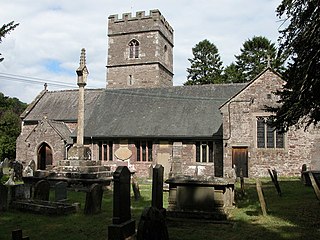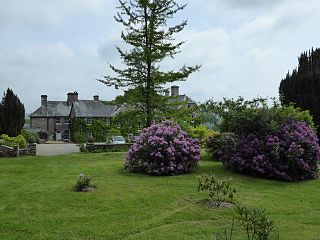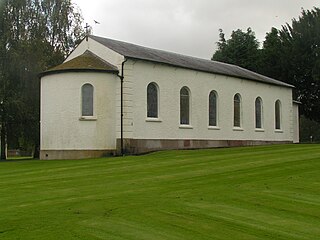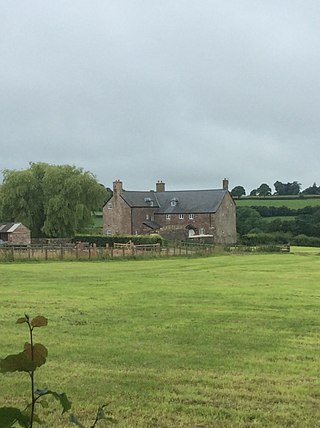
Llangwm is a small rural village and former community, now in the community of Llantrisant Fawr, in Monmouthshire, south east Wales. It is located 3 miles (4.8 km) east of Usk, on the B4235 Chepstow to Usk road. The main village is at Llangwm Uchaf, with a smaller and more dispersed settlement about 1 mile (1.6 km) to the north-east at Llangwm Isaf .The other settlement in the community is Llansoy. In 2022 the community was abolished and merged with Llantrisant Fawr.

St Mary's Priory Church, in Whitecross Street, Monmouth, Monmouthshire, Wales, is an Anglican church founded as a Benedictine priory in 1075. The current church dates mostly from the 18th and 19th centuries. It was designated a Grade II* listed building in 1952. It is one of 24 buildings on the Monmouth Heritage Trail.

LlanvihangelCourt, Llanvihangel Crucorney, is a Tudor country house in Monmouthshire, Wales. The architectural historian John Newman, in his Gwent/Monmouthshire volume of The Buildings of Wales series described the court as "the most impressive and richly decorated house of around 1600 in Monmouthshire". The origins of the house are medieval, with a traditional date of construction of 1471. The building was given its present appearance by a substantial enlargement and re-casing of circa 1600 by Rhys Morgan, of the family of the original owners. In the very early 17th century it was owned briefly by Edward Somerset, 4th Earl of Worcester.

The Church of St Bridget (or St Bride) lies at the north end of the village of Skenfrith, Monmouthshire, Wales. It is an active parish church and a Grade I listed building. The church is dedicated to St Brigit (Welsh: Sant Ffraid), to whom 17 churches are dedicated across the country.

The Church of St Nicholas in the village of Grosmont, Monmouthshire, Wales, is a parish church dating from the 13th century. Its exceptional size reflects the importance and standing of the borough of Grosmont at the time of the church's construction and has led it to be called a "miniature cathedral". Largely unaltered from the time of its building, by the 19th century the church had seriously decayed and its tower was close to collapse. It was rescued from dereliction in a restoration undertaken by John Pollard Seddon and financed by John Etherington Welch Rolls.

The Church of St Mary stands in the centre of the village of Magor, Monmouthshire, Wales. It was designated a Grade I listed building in 1963. The church is the lead church of the Netherwent Ministry Area, led by Rev. Canon Jeremy Harris, and administers to a population of around 32,000.

The Church of St John is the parish church of Llandenny, Monmouthshire, Wales. It is in the Perpendicular style and is a Grade I listed building as of 27 November 1953.

The Church of St Nicholas, Trellech, Monmouthshire is a parish church with its origins in the 14th century. The historical and architectural evidence suggests that it was constructed largely in a single building period c.1300. The style is Decorated Gothic. The church was extended and repaired in the 18th century, and underwent two major reconstructions in 1893 and 1992. An "exceptionally fine and well preserved medieval church", it is a Grade I listed building. It remains an active parish church in the parish of Trellech and Penallt.

The Church of St Martin, Cwmyoy, Monmouthshire, Wales, was begun in the 12th century, although most of the current structure dates from the 13th century. The church is most notable for its extreme tilt, the result of a landslide. This has led to many attempts to strengthen the church and prevent its collapse, through the use of massive tie beams and buttresses. The church is in the Gothic style, and has a chancel, nave, south porch, and western tower. A round-headed north window dates to the 12th century, and the nave roof has been dated to the late 13th or early 14th century. St Martin's is a Grade I listed building and an active parish church. It is dedicated to St Martin of Tours.

The Church of St Teilo is the parish church of Llantilio Pertholey, Monmouthshire, Wales. "An unusually large and varied church", it is a Grade I listed building as of 1 September 1956

The Church of St Teilo is the parish church of Llantilio Crossenny, Monmouthshire, Wales. "An unusually grand cruciform church", with an Early English tower crossed by a Decorated chancel, it was designated a Grade I listed building on 19 November 1953

The Argoed, Penallt, Monmouthshire, Wales, is a Victorian country house dating from the 1860s, with earlier origins from the late 16th and early 17th centuries. It is a Grade II* listed building and the garden is listed on the Cadw/ICOMOS Register of Parks and Gardens of Special Historic Interest in Wales. The English meaning of the Welsh word argoed is 'by a wood'.

Monmouthshire is a county and principal area of Wales. It borders Torfaen and Newport to the west; Herefordshire and Gloucestershire to the east; and Powys to the north. The largest town is Abergavenny, with the other major towns being Chepstow, Monmouth, and Usk. The county is 850 km2 in extent, with a population of 95,200 as of 2020. The present county was formed under the Local Government (Wales) Act 1994, which came into effect in 1996, and comprises some sixty percent of the historic county. Between 1974 and 1996, the county was known by the ancient title of Gwent, recalling the medieval Welsh kingdom. In his essay on local government in the fifth and final volume of the Gwent County History, Robert McCloy suggests that the governance of "no county in the United Kingdom in the twentieth century was so transformed as that of Monmouthshire".

The Church of St Jerome stands in the settlement of Llangwm Uchaf, (upper) Llangwm, in a remote part of Monmouthshire, Wales. Originally constructed in the twelfth century, in an Early English style, it was heavily restored in the nineteenth century. The church has a "large and unusual" tower, an "outstanding" late medieval rood screen and Victorian interior fittings of "exceptional quality". After being declared redundant by the Church in Wales, the church is now administered by the Friends of Friendless Churches. It was designated a Grade I listed building on 19 August 1955.

The Church of St Mary at Tregare, Monmouthshire, south east Wales, is the parish church of the village of Tregare. Dating originally from the fourteenth century, the tower is later, probably of the fifteenth century. The church was restored in the early twentieth century. Built in the Decorated style, the church is a Grade II* listed building.

The Church of St Cybi, Llangybi, Monmouthshire is a parish church with its origins in the 13th or 14th century. Refurbished in the 15th century, the church was restored in 1909–10. The interior has a notable collection of medieval wall paintings, in particular a Christ of the Trades, dating from c.1460. The church is an active parish church and part of the recently-formed Heart of Monmouthshire Ministry Area. It is a Grade II* listed building and the architectural writer John Newman, recording the church in the Buildings of Wales series, described it as "one of the most interesting in the Usk Valley."

The Church of St Mary and St Michael, Llanarth, Monmouthshire, was built as the family chapel for Llanarth Court. It was the first Roman Catholic church constructed in the county since the Dissolution of the Monasteries in the mid-16th century. Built circa 1790, some decades before the Roman Catholic Relief Act 1829, it was designed to look like an orangery, or barn, in order not to attract anti-Catholic hostility. It is considered one of the oldest, if not the oldest, Catholic churches in Wales.

The Church of St Peter, Llanwenarth, Monmouthshire is a parish church with reported origins in the 6/7th centuries. The current building dates from the early 14th century. Rebuilt in the 19th century, it was listed Grade II* in 1956. It remains an active Church in Wales church in the parish of Llanwenarth Citra.

The Church of St Cadoc, Llangattock-Juxta-Usk, Monmouthshire is a parish church with its datable origins in the 15th century. The church was restored in 1827 and again in 1864–5. It is a Grade II* listed building.

Pant-glas Farmhouse and its associated barn at Llanishen, Trellech, Monmouthshire date from the early 16th and 17th centuries respectively and are both Grade II* listed buildings.






















